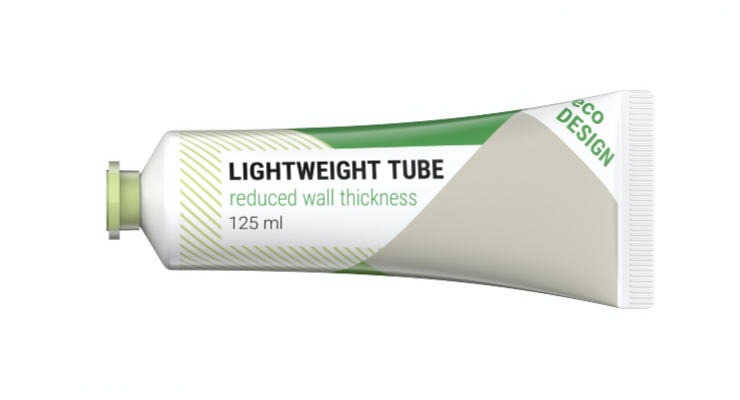Charles Sternberg, Assistant Editor02.23.21
Hoffmann Neopac, a provider of responsible packaging for a broad array of industries and applications, has introduced a lighter plastic tube solution comprising up to 30% less virgin materials. The latest addition to the company’s EcoDesign series of eco-friendly tubes, the new Lightweight Tube aligns with packaging industry desires to minimize carbon footprint and materials waste.
Brand owners in various sectors are increasingly looking to reduce or replace the use of virgin plastic packaging materials to enhance their products’ sustainability profiles. The use of such lighter-weight packaging reduces both shipping costs and extended producer responsibility (EPR) fees.
Neopac’s Lightweight Tube is available in plastic tube diameters ranging from 30-50mm, and in four substrate varieties: Polyethelene and Recycled tubes, each with or without EVOH barrier. Material reduction is most prominent in the tubes’ wall thickness, which has been reduced from 0.5 mm to 0.35 mm without sacrificing exemplary haptics. Low profile closures are already in the pipeline to achieve maximum weight reduction in plastic tubes.
Neopac estimates that, in its own packaging manufacturing operations, the new tubes will eliminate the need for as much as 4.6 tons of HDPE materials per one million tubes produced. This translates to an overall carbon footprint reduction of about 8.6 tons of CO2 per million tubes manufactured.
“Finding ways to reduce the overall amount of materials is mandatory for packaging suppliers to move toward ambitious sustainability goals,” said Cornelia Schmid, head of marketing for Hoffmann Neopac. “Always, a challenge is to boost a package’s eco-friendliness without sacrificing product protection or aesthetics. The new Lightweight Tubes are viable solutions for brand owners in a number of industries, helping meet increasing consumer desires for comprehensive product sustainability.”
Other solutions in Neopac’s EcoDesign portfolio include the Recycled Tube featuring 70% recycling material, 64% of which is PCR; the Sugarcane Tube, made from renewable raw materials; and the PICEA wood tube, comprised of 95% renewable material in the tube body and shoulder – including 10% of spruce wood from wood waste in sawmills.
Brand owners in various sectors are increasingly looking to reduce or replace the use of virgin plastic packaging materials to enhance their products’ sustainability profiles. The use of such lighter-weight packaging reduces both shipping costs and extended producer responsibility (EPR) fees.
Neopac’s Lightweight Tube is available in plastic tube diameters ranging from 30-50mm, and in four substrate varieties: Polyethelene and Recycled tubes, each with or without EVOH barrier. Material reduction is most prominent in the tubes’ wall thickness, which has been reduced from 0.5 mm to 0.35 mm without sacrificing exemplary haptics. Low profile closures are already in the pipeline to achieve maximum weight reduction in plastic tubes.
Neopac estimates that, in its own packaging manufacturing operations, the new tubes will eliminate the need for as much as 4.6 tons of HDPE materials per one million tubes produced. This translates to an overall carbon footprint reduction of about 8.6 tons of CO2 per million tubes manufactured.
“Finding ways to reduce the overall amount of materials is mandatory for packaging suppliers to move toward ambitious sustainability goals,” said Cornelia Schmid, head of marketing for Hoffmann Neopac. “Always, a challenge is to boost a package’s eco-friendliness without sacrificing product protection or aesthetics. The new Lightweight Tubes are viable solutions for brand owners in a number of industries, helping meet increasing consumer desires for comprehensive product sustainability.”
Other solutions in Neopac’s EcoDesign portfolio include the Recycled Tube featuring 70% recycling material, 64% of which is PCR; the Sugarcane Tube, made from renewable raw materials; and the PICEA wood tube, comprised of 95% renewable material in the tube body and shoulder – including 10% of spruce wood from wood waste in sawmills.




























